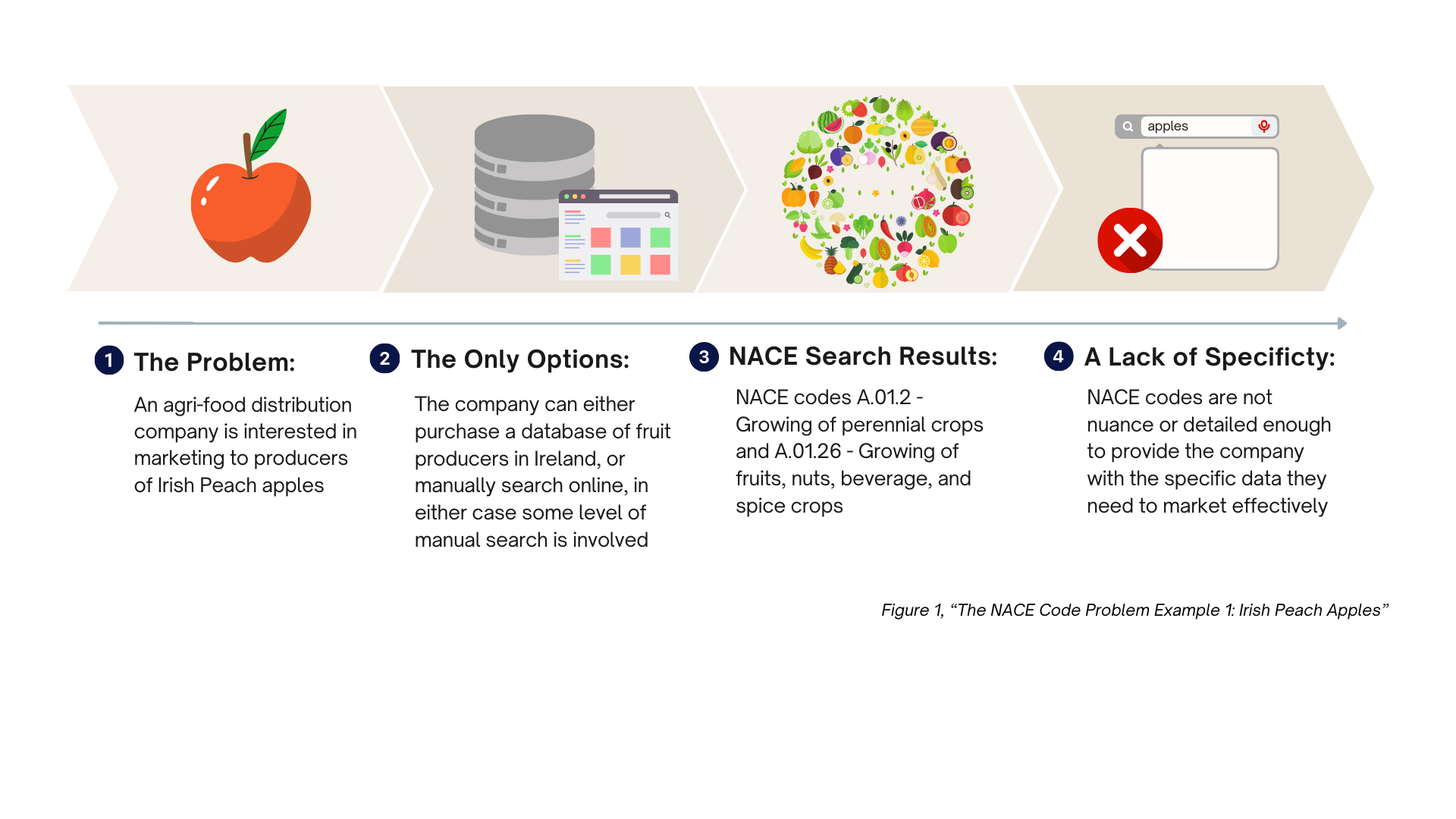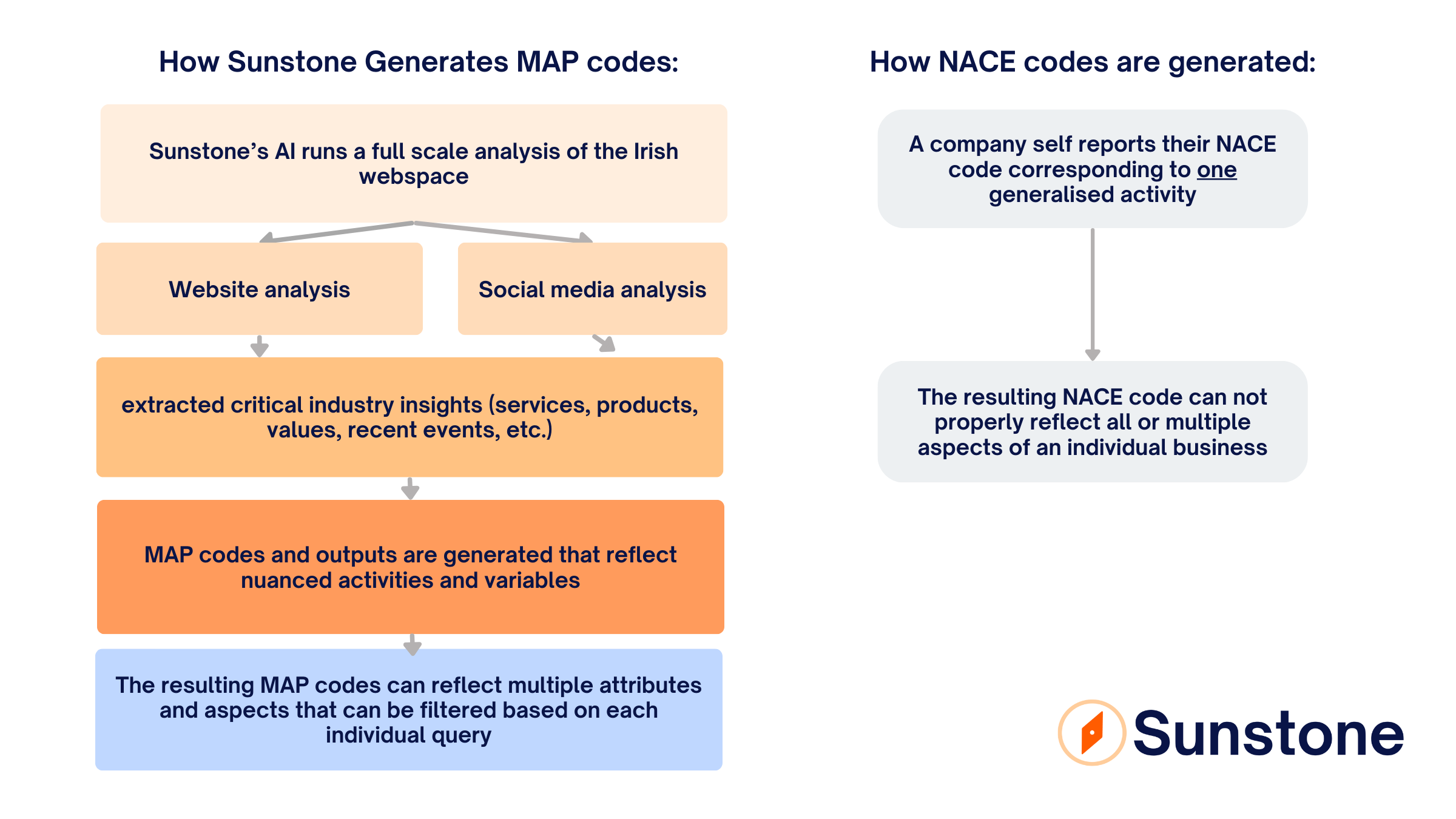

Why NACE Codes Fall Short, and How MAP is Changing the Game
Since 1970, NACE codes have been the most widely used classification system throughout Ireland and Europe for grouping organisations according to generalised business activities.
Initially, these codes were effective for providing a broad overview of various industries, helping businesses and governments organise and analyse economic data.
However, as the business landscape has evolved, a critical flaw in NACE codes has become increasingly apparent: a lack of nuance.
So…Why Does Why Specificity Matter?
NACE Codes Are Too Broad for Modern Businesses
NACE codes categorise businesses into broad sectors, often missing the finer details that differentiate one company from another within the same industry. This lack of specificity can hinder modern marketing efforts that rely on precise targeting and personalization.
For instance, two companies classified under the same NACE code might operate in entirely different niches with unique customer bases and marketing needs. Traditional NACE codes fail to capture subtleties (See Figure 1 “The NACE Code Problem), leading to ineffective marketing strategies and missed opportunities for businesses to connect with new audiences.
As a result, businesses only using NACE codes for market segmentation and targeting may find themselves at a disadvantage, unable to fully understand and reach their ideal customers.


A Brand New Era of Business Classifications
In modern marketing, the shortcomings of NACE codes have become glaringly apparent. Broad categorizations are no longer sufficient for the granular level of analysis needed to gain competitive insights and tailor marketing campaigns.
Thus, we have created an advanced data classification system that analyses company activities in the marketplace based on their digital footprint. We call this system Market Activity Profiling System (or “MAPS” for short). Using MAPS, we can create a more holistic view of a company based on its products, services, values, and recent events.
Using MAPS as the basis for our data collection and classification, Sunstone has built the largest, most accurate database in Ireland with a full range of data variables never before offered or collected by any other data company. MAPS marks a groundbreaking advancement in the realm of data classification, presenting a dynamic and relevant alternative to the outdated NACE codes.
How MAPS Works
The actual process behind how MAP works involves using Sunstone’s custom algorithm to scan, interpret, and analyse the entire Irish webspace. Each Sunstone business data entry gets an in-depth examination of website offerings and social media platforms, followed by sentiment analysis on any ethos or specific values conveyed. By feeding this rich dataset into our advanced language models, we can extract critical industry insights—ranging from services and products to values and mission statements, as well as pertinent recent events.
This information, once refined, is transformed into standardised structures that let us generate unique MAPS codes and descriptions that reflect the nuanced activities of various entities. MAPS codes also incorporate a comprehensive suite of financial and corporate data, providing a unique 360-degree view of the Irish corporate landscape that no other data company can compare to. Sunstone’s MAPS data includes all CRO-registered companies, ensuring complete and accurate market coverage.


Using MAPS for Analytics and Lead Generation
Using MAPS classifications, we created SaleSight, a service that combines MAPS with data analytics to help companies reveal hidden sales opportunities. SaleSight uses several machine learning techniques to recommend ideal client types to our customers based on embeddings generated from the MAPS output. From there, we can provide an evolving, targeted, nuanced sales funnel specific to each client.
We’ll illustrate how it works with an example of one of our client’s projects. In our partnership with an event management company, we applied the MAPS system and SaleSight Pro to reveal a comprehensive ecosystem surrounding data centres to supply targeted contacts for their Chief Information Officer Summit.
At first glance, the original NACE codes and descriptions of the companies seemed to have nothing to do with data centres. However, hidden relationships are where MAP codes and SaleSight’s capabilities truly shine. Using MAPS codes, SaleSight not only highlighted data centres but also identified key players in their infrastructure and operations by analysing their websites and services, which traditional NACE code searches had overlooked.
These findings, in addition to several hundred other companies we identified in the data centre space, demonstrate the nuance and interconnectedness of various sectors within the Irish business market that would not be found without a MAPS-based approach. SaleSight’s use of MAPS codes allows businesses to uncover and capitalise on opportunities that traditional marketing methods often miss—particularly those reliant on outdated NACE codes for generating marketing lists.
Partnering with Sunstone for Market Intelligence
Sunstone’s MAPS database and SaleSight have transcended the limitations of traditional NACE codes, ushering businesses into a new era of modernisation and strategic insight.
By creating MAPS codes, an Irish MAPS database, and MAPS-based analytics (SaleSight), Sunstone has set an unprecedented standard in business intelligence, enabling companies to achieve a new level of success unmatched in the industry.
In the ever-evolving technology landscape, Sunstone stands as a transformative guide, ensuring that Irish businesses have the MAPS data to lead the way into a new era of data innovation and market understanding.
If you’re interested in learning more about how MAPS data or SaleSight can transform your business, we invite you to visit our dedicated pages linked above.
Discover the full range of capabilities and benefits that our advanced data classification and analytics tools can offer.
Recent Comments